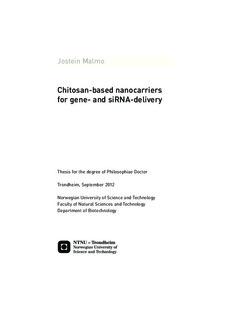| dc.contributor.author | Malmo, Jostein | nb_NO |
| dc.date.accessioned | 2014-12-19T13:14:53Z | |
| dc.date.available | 2014-12-19T13:14:53Z | |
| dc.date.created | 2012-10-29 | nb_NO |
| dc.date.issued | 2012 | nb_NO |
| dc.identifier | 563252 | nb_NO |
| dc.identifier.isbn | 978-82-471-3746-8 (printed ver.) | nb_NO |
| dc.identifier.isbn | 978-82-471-3748-2 (electronic ver.) | nb_NO |
| dc.identifier.uri | http://hdl.handle.net/11250/245832 | |
| dc.description.abstract | Gene therapy is promising for the treatment of many currently incurable diseases by delivering or silencing specific genes with pDNA or siRNA, respectively. Clinical trials have mostly been conducted with viral or relatively toxic nonviral nucleic acid delivery systems. The biopolymer chitosan have the recent years gained interest in nucleic acid delivery. However, chitosan lacks the efficiency of many alternative viral-, lipid- and polymer-based delivery systems. Hence, this study was initiated to characterize chitosan molecular properties favoring efficient delivery of pDNA and siRNA in mammalian cells. Chitosans were optimized by investigating a range of chain lengths (MW/DP), chain architectures, degrees of N-acetylation (FA) and concentration in the formulations (N/P). Promising siRNA-chitosan nanoparticles were investigated for their potential to increase the drug delivery in a blood-brain barrier (BBB) model by silencing the drug efflux pump P-glycoprotein (P-gp).
Self-branching of fully de-N-acetylated chitosans was investigated as a strategy to optimize the delivery efficiency of pDNA-chitosan nanoparticles. Self-branched (SB) and self-branched trisaccharide-substituted chitosan oligomers (SBTCO) of different MW (molecular weight) were synthesized, characterized and compared to their linear counterparts with respect to delivery efficiency, cellular uptake, formulation stability and cytotoxicity. While the linear unmodified chitosans failed to mediate efficient pDNA delivery in HeLa cells, the self-branching resulted in high transgene expression at the optimal combinations of MW and N/P. The most efficient nanoparticles formed with SBTCO exhibited a higher colloidal stability of formulation, efficient internalization without excessive cell surface binding and low cytotoxicity.
To identify fundamental chitosan molecular properties for efficient gene silencing, siRNA-chitosan nanoparticles were prepared from chitosans of various DP (degree of polymerization), chain architectures and FA at N/P 10-60. Structure-activity relationships were determined by the cellular uptake of siRNA and the knockdown efficiency. Additionally, the nanoparticle cytotoxicity was evaluated on the basis of cellular metabolic activity and membrane integrity. The results show that the most efficient gene silencing was achieved using fully de-N-acetylated chitosans with number average degree of polymerization (DPn)>50 and N/P>10. These chitosans mediated efficient siRNA delivery at low siRNA concentrations and potent long-term silencing with minimal cytotoxicity.
The BBB limits the availability of drugs to therapeutic targets in the central nervous system. The barrier is maintained by membrane bound efflux pumps efficiently transporting specific xenobiotics back into the blood. The efflux pump P-gp is expressed at high levels in brain endothelial cells and has several drug substrates. Consequently, siRNA mediated silencing of the P-gp gene is a feasible strategy to improve the brain drug delivery. Herein, siRNA-chitosan nanoparticles selected on basis of the structureactivity optimization were investigated for potential silencing of P-gp in a BBB model cell line. The results show that the transfection of rat brain endothelial cells mediated effective knockdown of P-gp with subsequent decrease in P-gp substrate efflux. This increased the cellular delivery and efficacy of the model drug doxorubicin. | nb_NO |
| dc.language | eng | nb_NO |
| dc.publisher | Norges teknisk-naturvitenskapelige universitet, Fakultet for naturvitenskap og teknologi, Institutt for bioteknologi | nb_NO |
| dc.relation.ispartofseries | Doktoravhandlinger ved NTNU, 1503-8181; 2012:223 | nb_NO |
| dc.relation.haspart | Malmo, Jostein; Varum, Kjell M.; Strand, Sabina P.. Effect of Chitosan Chain Architecture on Gene Delivery. Biomacromolecules. (ISSN 1525-7797). 12(3): 721-729, 2011. <a href='http://dx.doi.org/10.1021/bm1013525'>10.1021/bm1013525</a>. | nb_NO |
| dc.relation.haspart | Malmo, Jostein; Sorgard, Hanne; Varum, Kjell M.; Strand, Sabina P.. siRNA delivery with chitosan nanoparticles. Journal of Controlled Release. (ISSN 0168-3659). 158(2): 261-268, 2012. <a href='http://dx.doi.org/10.1016/j.jconrel.2011.11.012'>10.1016/j.jconrel.2011.11.012</a>. | nb_NO |
| dc.relation.haspart | Malmo, J; Sandvig, A; Vårum, KM; Strand, SP. Nanoparticle mediated P-glycoprotein silencing for improved drug delivery across the blood-brain barrier: a siRNA-chitosan approach. . | nb_NO |
| dc.title | Chitosan-based nanocarriers for gene- and siRNA-delivery | nb_NO |
| dc.type | Doctoral thesis | nb_NO |
| dc.contributor.department | Norges teknisk-naturvitenskapelige universitet, Fakultet for naturvitenskap og teknologi, Institutt for bioteknologi | nb_NO |
| dc.description.degree | PhD i bioteknologi | nb_NO |
| dc.description.degree | PhD in Biotechnology | en_GB |

